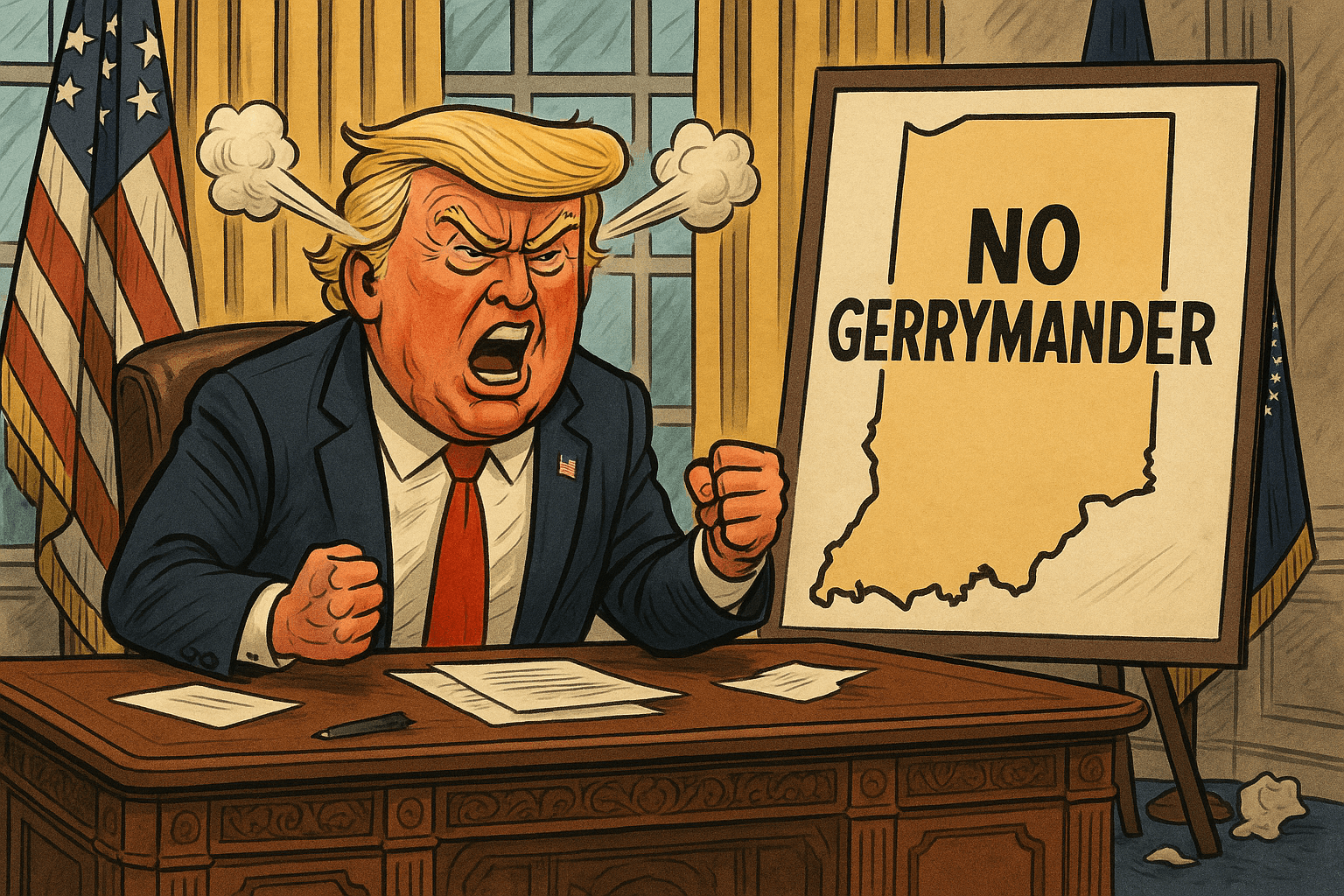The 10 Worst Gerrymandered States in the Country

Monday marked another escalation in the mid-cycle redistricting fight between Republicans in Texas and Democrats in California – with one in another special session to add 5 more GOP seats, and the other maneuvering to counter this with 5 new Democratic seats.
All of this is for the 2026 midterm election cycle where a razor-thin majority in the U.S. House of Representatives is on the line.
Texas is doing this on the orders of President Donald Trump. California is responding on the orders of Governor Gavin Newsom. However, both efforts would create vastly lopsided congressional maps that do not represent how party affiliation breaks down in each state.
For example, if Texas lawmakers secure 5 more seats for the Republican Party, they will extend their majority in their U.S. House delegation from 65% to potentially 79%, and while President Trump believes he is entitled to these seats, he won Texas with 56% of the vote.
And, according to data modeling from the nonpartisan research group L2 Data, Republicans do not have the majority they think they have in the state.
Conversely, if California Democrats add 5 more seats to their numbers (assuming they keep any swing districts they currently hold), their majority in the state's U.S. House delegation will increase to 48 of the state’s 52 seats (or 92.3%, up from 82.7%).
Former Vice President Kamala Harris won California in 2024 with 58.5% of the vote, and according to the latest voter registration numbers, Republicans make up 25.5% of the registered electorate.
In other words, Newsom – in the name of “protecting democracy” – would join Texas in having the most egregious gerrymanders in the U.S. until California’s independent redistricting commission redraws maps again in 2031.
That is, if voters approve it at the ballot box.
This has been called a “race to the bottom” by many better elections groups and reformers. No matter who wins, it ultimately is not about representation. It is about partisan gamesmanship.
The U.S. is Finally Talking About This Assault on Voters' Rights
There is no question that this all started with Trump calling on Texas Republicans to protect the GOP majority in the U.S. House – and because it’s Trump, the media is covering the state-by-state redistricting in a way that doesn’t make it sound normal for once.
Democrats condemn Texas Republicans for doing the bidding of the president. In response, Republicans and pro-Trump pundits point to the way Democrats have unfairly drawn maps in states like Illinois and Maryland.
And in Maryland, this means Democrats have control of all but one of the state’s 8 seats.
Both sides point the finger. They claim it's really the “other side” that has been unfair. Yet, for the first time, Democratic-leaning media and Republican-leaning media have devoted extensive coverage to the fact that both sides have denied voters accurate representation.
Illinois maps, for example, are just as bad as North Carolina maps.
For the first time, voters see coverage that makes it clear – this shouldn’t be normal. Much of the conversation in the press focuses on vote share in the 2024 election, but it's worth noting that presidential votes do not equal a perfect proxy for congressional votes.
It can be a simple, comparable yardstick, but other factors matter like geography, incumbency, and candidate quality also matter.
The 10 Worst Gerrymandered States in 2025
The following list of the 10 most gerrymandered states is based on recent court decisions, academic analyses (like those from Princeton Gerrymandering Project and FairVote), and voter turnout data.
These states are considered among the most egregious due to how distorted their maps are in favor of one party, how little competition exists in elections, and how badly maps reflect voter preferences.
1. North Carolina
Why: North Carolina’s congressional maps are notoriously gerrymandered in favor of Republicans. In 2022, Republicans won 71.43% of congressional seats despite receiving about 50.7% of the statewide vote.
In 2024, Republicans won 50.86% of the statewide vote -- highlighting that congressional makeup should be about 50-50.
Key Issue: After a state Supreme Court flipped from Democratic to Republican control in 2023, it overturned a previous ruling that struck down partisan gerrymanders, greenlighting new maps that maximized GOP control.
2. Maryland
Why: Maryland Democrats have long drawn congressional maps that crack Republican voters into multiple Democratic-leaning districts. Democrats won 62.62% of the statewide vote in 2024 -- but hold all but one congressional seat (7 out of 8).
Key Issue: The 2022 map was so extreme that even a Democratic judge ordered it redrawn for being an "extreme gerrymander," but in response to redistricting in Texas, Maryland Democrats may try to take the only seat held by a Republican.
3. South Carolina
Why: With Republicans controlling the General Assembly, they’ve had a free hand to maximize their advantage. Republicans won 58.23% of the statewide vote in 2024. However, they hold all but one of the state’s US House seats (6 of 7).
Key Issue: In Alexander v. South Carolina State Conference of the NAACP (2024), the U.S. Supreme Court rejected a constitutional challenge to SC-01, which civil rights groups said was redrawn to kick Black voters out in order to give Republicans a safe seat.
4. Illinois
Why: Illinois Democrats drew maps that consolidated power by eliminating Republican seats through strategic district collapses and splits. Democrats won 54.37% of the 2024 statewide vote but hold 82.35% of seats (14 of 17).
Key Issue: Several Republican strongholds were “cracked” or merged to reduce GOP representation. The 2022 map was criticized for having only one truly competitive seat out of 17.
5. Texas
Why: Even before the current mid-cycle redistricting controversy, Texas was considered one of the worst gerrymandered states. Despite consecutive election cycles of close contests between Republicans and Democrats, Republicans control 65% of U.S. House seats.
Key Issue: Adding 5 Republican seats would extend this majority to 79%, even as nonpartisan data shows that Republicans do not even make up a majority of voters anymore.
6. Wisconsin
Why: For over a decade, Wisconsin Republicans have entrenched themselves in the state legislature with maps that protect their super-majority in the legislature and in Congress despite a near-even split between the two major parties at the ballot box.
Republicans won 49.70% of the statewide vote in 2024 and hold 75% of U.S. House seats (6 of 8).
Key Issue: In 2018, Democrats won all statewide offices and 53% of the vote but only 36% of Assembly seats.
7. New York
Why: Democrats tried to push through a heavily gerrymandered map in 2022, which was struck down by the courts. A court-appointed special master drew more balanced maps.
Key Issue: Democrats may follow California’s lead and attempt another aggressive redraw for 2026. They currently hold 73% of seats, while they won 55.91% of the statewide vote in 2024.
8. Florida
Why: Under Governor Ron DeSantis, Florida scrapped bipartisan compromise maps and adopted a plan that dismantled a Black-opportunity district in North Florida.
Key Issue: Courts have ruled DeSantis’s map unconstitutional for racial discrimination, but enforcement has been delayed. The GOP-drawn map helped deliver 20 GOP House seats vs. 8 Democratic in 2022 (71.43%).
Republicans took 56% of the statewide vote in 2024. But the question is – will Florida join the mid-cycle redistricting battle?
9. Ohio
Why: Despite passing anti-gerrymandering constitutional amendments, Ohio Republicans drew maps that a bipartisan redistricting commission refused to make fair.
For example, Republicans took 55% of the vote in 2024 but hold two-thirds of U.S. House seats.
Key Issue: The state Supreme Court ruled 7 times that GOP-drawn maps were unconstitutional. Now, state lawmakers are considering new maps and some Republicans think the congressional map should be 12-3 in their favor.
10. Nevada
Why: Nevada is one of the rare examples of a party winning a majority in a statewide vote, despite only holding a quarter of the state’s congressional seats. Nevada is a competitive state due to its large independent voter population.
Key Issue: Republicans won 50.59% of the statewide vote in 2024, but hold only 25% of Nevada's U.S. seats (1 of 4). Nevada was the only state in 2024 where the party that carried the state for president won a minority of House seats.
Each election delivers a near equal split between the parties -- yet the congressional delegation is not divided 50-50.
 Shawn Griffiths
Shawn Griffiths







